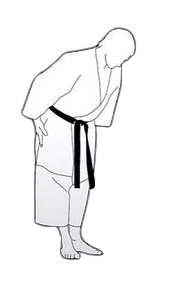Shōtōkan foundation is typically similar across the globe, however, the way these knowledge are passed down solely depends on the instructor and his/her point of view. There are many ways of learning and acquiring new skills but what truly matters is the end result and your understanding of the subject.
A typical class begins with the senior student or the instructor yelling out a command "Seiretsu" which means to "line up in rank" order. Once you hear this command you must move quickly and line up in your respective order. When facing the front "Shomen" the rank order is from Right to Left, from Dan & Black belts to Kyu ranks.
The class then begins with a ceremony by either a standing bow ceremony (quick) or the traditional kneeling bow ceremony (longer), the latter which is the formal Japanese ceremony also helps students prepare mentally for the training by giving them a separation time between karate class and there previous activities.
The class then goes through a warm-up session and then training begins. Shōtōkan Karate criteria is composed of three key elements; Kata, Kihon and Kumite.
Kihon (基本)
Kihon or simply known as "Basic Fundamentals" are mostly techniques that have derived from katas. This form of training was originally introduced to aid us in understanding and developing our katas. We also use kihons on the principles to better understand techniques on how to stand, block, punch and kick. At first you begin with single technique at a time, then in combinations which is great development for motor skills and neurological paths.
Kata (型)
Kata or also known as "Form" is a set of prearranged combinations of technique adhering to strick proven guidelines. These forms are practiced as a general class but should be mastered individually, I always remind my students that "Kata is Same, but we are Individual" therefor everyone's physical and mental attributes will be and learn at a different pace. Kata also teaches the students self-defence techniques and if you look closely, every beginning move of each kata begins with a defensive technique .
Kumite (組手)
Kumite or also known as "Sparring" is training with another student where we technique acuired from Kata and Kihons are utilised and deployed to immobilise the attacker in a controlled manner. This could be against someone your one build, some smaller or even larger, thus teaching the student to apply the techniques against any opponent.
Class ends with the recital, in Japanese, of Doju-kun and an end-of-class ceremony. Doju-kun are the principles of the dojo.

Karate-Do begins with Respect

